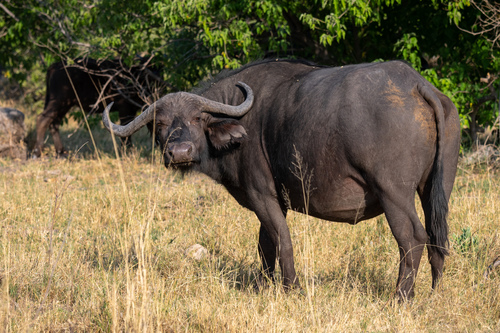
African Buffalo
The African buffalo, or Syncerus caffer, roams Africa's savannas and swamps. With its iconic curved horns and formidable stature, this unpredictable herbivore is vital for ecosystem balance, influencing vegetation and serving as prey for apex predators.
15-22 years
Lifespan
600.0 - 907.0 kg
Weight
Length: 1.7 - 1.8 m
Size
Brown, Grey, Black
Color
22 mph
Top Speed
Near Threatened
Conservation Status
Decreasing
Population Trend
Characteristics
Syncerus caffer, commonly known as the African buffalo, is a large bovine found in sub-Saharan Africa. It thrives in diverse habitats such as savannas, swamps, and forests. Known for its robust build, it has a thickset body, large curved horns, and a reputation for unpredictable behavior, playing a crucial role in maintaining the balance of its ecosystem.
Distribution Range of the African Buffalo
Syncerus caffer, commonly known as the African buffalo or Cape buffalo, is native to Sub-Saharan Africa. Its geographical distribution includes countries such as South Africa, Botswana, Namibia, Zimbabwe, Mozambique, Tanzania, Kenya, Uganda, and as far north as Ethiopia. The species is widespread across savannas, woodlands, and forests within this region.
African Buffalo's Habitat
Environmental Conditions
The African buffalo inhabits a range of environments but is most commonly found in grasslands, savannas, and areas with dense bush or woodlands. These environments provide both the grass they feed on and the cover needed for protection from predators. The climate in these regions typically includes a wet season and a dry season, with temperatures ranging from 20°C to 30°C (68°F to 86°F).
Ecological Niche
The African buffalo is a large herbivore and plays a crucial role in its ecosystem as a grazer. By consuming large amounts of grass, they help maintain the savanna ecosystems, preventing overgrowth and promoting a balance of plant species. They often travel in herds, which can significantly impact the landscape and influence the distribution of other wildlife species. Their presence also supports a variety of predators, such as lions and hyenas, which rely on them as a significant food source.
Copyright @ Nature Style Limited. All Rights Reserved.
 English
English